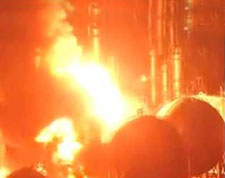5%? That isn’t much but I guess it is better than nothing.
http://www1.umn.edu/news/news-releases/2009/UR_CONTENT_109539.html
University of Minnesota to launch energy conservation program at Beautiful U Day kick off event Thursday
Media Note:
Photo opportunity as people sign conservation pledge at 8 a.m. tomorrow (April 23)
Contacts: Tim Busse, University Services, (612) 624-2863,
Patty Mattern, University News Service, (612) 624-2801
The University of Minnesota has set the goal of reducing energy consumption by 5 percent by the end of 2010. University of Minnesota President Robert Bruininks and Vice President of University Services Kathleen O’Brien will introduce a new campus-wide energy conservation program the Beautiful U Day Kick Off event at 8 a.m. Thursday, April 23 at the Electrical Engineering and Computer Sciences Building, 200 Union St. S.E., Minneapolis.
A 5 percent reduction each year will save the university $2.25 million and result in 25,000 fewer tons of CO2 being released into the atmosphere. Meeting this ambitious goal will require a campus-wide effort, said Tim Busse, University Services communications director. To work toward that goal, the university is challenging students, faculty and staff, as well as departments and academic units, to commit to energy conservation by taking the Energy Conservation Pledge. The theme of Beautiful U Day is “It All Adds Up.”
During the kick off event, stations will be set up where students, faculty and staff can sign the Energy Conservation Pledge. The pledge begins “While my individual steps appear small, I understand that It All Adds Up. Working together, we can make huge leaps in reducing emissions, cutting electrical usage and saving University resources.”
Suggestions for conserving energy include: turning off computers at night; turning off the lights when out of the room for more than 10 minutes; unplug cell phone chargers that draw power unnecessarily and use the stairs rather than the elevator. “All these efforts are small steps but it all adds up,” Busse said.
Tags: University Services
:}
More Tomorrow.
:}




 Before the Industrial Revolution of the 1890s, human beings had only a moderate need for energy. Man mostly relied on the energy from brute animal strength to do work.
Before the Industrial Revolution of the 1890s, human beings had only a moderate need for energy. Man mostly relied on the energy from brute animal strength to do work. Electric energy was discovered by a Greek philosopher named Thales, about 2500 years ago. Thales found that, when rubbing fur against a piece of amber, a static force that would attract dust and other particles to the amber was produced which now we know as the “electrostatic force”.
Electric energy was discovered by a Greek philosopher named Thales, about 2500 years ago. Thales found that, when rubbing fur against a piece of amber, a static force that would attract dust and other particles to the amber was produced which now we know as the “electrostatic force”. Around 1000 BC, the Chinese found coal and started using it as a fuel. It burned slower and longer than wood and gave off more heat. It served as an excellent fuel and continued to be used for centuries thereafter. When Marco Polo returned to Italy after an exploration to China in 1275, he introduce coal to the Western world.
Around 1000 BC, the Chinese found coal and started using it as a fuel. It burned slower and longer than wood and gave off more heat. It served as an excellent fuel and continued to be used for centuries thereafter. When Marco Polo returned to Italy after an exploration to China in 1275, he introduce coal to the Western world. 
 This first-person view is the most terrifying and astonishing video I’ve seen of the Japan tsunami. Initially everything seems ok, just a mild wave coming towards the camera. But keep watching—the sea goes Godzilla and destroys everything.
This first-person view is the most terrifying and astonishing video I’ve seen of the Japan tsunami. Initially everything seems ok, just a mild wave coming towards the camera. But keep watching—the sea goes Godzilla and destroys everything.